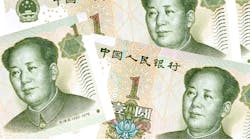In recent years, the world has witnessed an extraordinary growth story, watching as China has reintegrated into the global financial system and evolved from a command-driven economy to a market-driven economy. Even with a recent slowdown in its otherwise steady growth, the Chinese economy continues to expand. Chinese consumer spending is expected to increase by 8.3% in 2015, after growing by 8.1% in 2014. By 2050, China's per capita income is expected to soar by 800%.
And while China has long been a leader in international trade, there are increasing opportunities for foreign companies – especially manufacturers – to take part in the country's growth story. For instance, in 2014, China's State Council opened 80 major projects to private sector investment, spanning areas such as port construction, IT infrastructure and clean energy projects. The Chinese government has pledged $40 billion to improve transport connections along trade routes, as trade with China is expected to rise in the United States and elsewhere.
This is great news for manufacturers, especially middle market manufacturers, and great news for the U.S. economy.
China is the world's largest trading nation and the United States' second largest trading partner, behind Canada. Nearly seven in 10 U.S.-based businesses, including manufacturers, expect their trade with China to increase in the next 12 months, up from 55% in 2014, which is higher than the 54% global average, according to HSBC's Global Renminbi (RMB) Internationalization Study 2015.
At the same time, middle market manufacturers help drive the U.S. economy and have been an important part of the economic recovery over the past few years. In fact, the 7,500 middle market manufacturers in the U.S. contribute about 2% to national economic output and generate about 3 million jobs, according to a report on middle market companies, "Hidden Impact: The Vital Role of Mid-Market Enterprises," by HSBC Bank USA, N.A (HSBC). Middle market manufacturers also have an important multiplier effect. In the U.S., middle market companies help contribute an extra $2.2 trillion in economic output through indirect benefits to the wider economy as a result of demand generated in supply chains and induced economic impacts from wage-financed consumption by their employees.
However, to make the most of China’s growth story, U.S. manufacturers should become familiar with and use China’s currency, the renminbi (RMB) to trade and make payments with their suppliers and buyers.
While some may still believe that the RMB is a closed currency that's difficult to use, it is actually now fully convertible for trade purposes. Companies in China have been able to settle cross-border trade in RMB since March 2012, and HSBC predicts that half of all trade with China will be settled using the RMB by 2020. Because U.S. businesses have been slower to adopt the RMB than their international counterparts, those willing to give the currency a try will have a competitive advantage.
Manufacturers Benefit by Using RMB
Manufacturers using the RMB can experience numerous benefits, including deepening relationships with suppliers, reaching new suppliers, reducing their exposure to currency fluctuations, and gaining market share. For instance, adopting the currency may allow a manufacturer to negotiate better prices or terms with Chinese suppliers. Sixty-one percent of Chinese companies recently surveyed by HSBC said that foreign firms doing business with them gain financial advantages by using the RMB. The same percentage also said that foreign companies gain relationship advantages by using the RMB
For those selling goods to Chinese companies, using the RMB when pricing makes it easier for Chinese buyers to compare costs. So, U.S. businesses that use the RMB might also have a competitive edge when it comes to gaining market share. In addition, companies that adopt the RMB can use the Internet to sell directly to Chinese consumers in their own currency, opening doors to China's burgeoning domestic market.
Using the RMB can also help manufacturers simplify international trade processes. If prices are fixed in RMB, there will be fewer renegotiations as foreign exchange rates change, simplifying long-term contracts. Additionally, being RMB-flexible allows manufacturers to reduce foreign exchange risk. In fact, 63% of RMB users participating in our survey said that reducing foreign exchange risk is a key reason they use the currency. Because the RMB is now fully deliverable and convertible in the offshore market, companies can hedge exposure using forwards, options, interest rate swaps, cross-currency swaps and other derivatives, just as they would for other global currencies.
In the past, foreign manufacturers operating in China could only return cash to their own currency through dividend payments. But today, there are alternatives such as cross border intercompany loans or cash pooling solutions that provide ways to more easily repatriate capital. Onshore and offshore cash pools can be linked to improve working capital efficiency.
As China's importance in the world economy continues to increase, smart manufacturers are seeking ways to get in on the country's growth and gain access to new investors and capital.
Kevin Quinn is senior vice president and head of U.S. Middle Market Corporate Banking, Midwest and Upstate New York, HSBC Bank USA, N.A.



